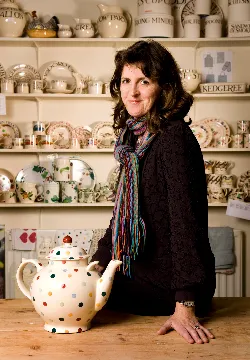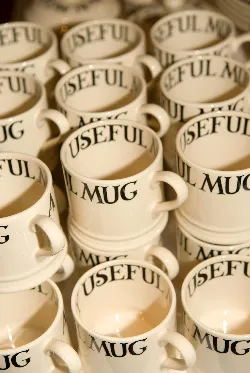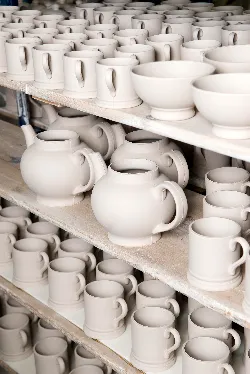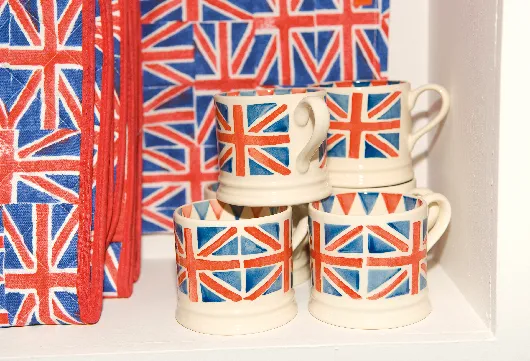Emma Bridgewater is dressed simply in jeans, shirt and comfy suede boots as she welcomes us to her red brick Victorian pottery in Stoke-on-Trent. No one stands on ceremony here – they’re all too busy. Her home is in Norfolk and her flagship shop in Fulham, but since 1996, when she became the proprietor of Eastwood Works in Hanley, this has been the heart of her domain; the place where 4,000 pieces of Bridgewater pottery are made every day.

From 6am in the morning until 10pm at night, the pottery hums with activity. Huge mixing or ‘blunging’ machines prepare the Cornish china clay; apron-clad decorators embellish each biscuit-fired piece with hand cut sponges or litho prints and all the while, trolleys laden with mugs, jugs, teapots, bowls and dishes trundle their wares to the next stage in production. The kilns, constantly on the go, provide a blanket of warmth.
To have created a beacon of light in the decimated Stoke potteries with a range of ‘Made in England’ china, has been no mean feat. ‘There have been plenty of ups and downs,’ confesses Emma, but the naïve charm of her earthenware has garnered fans. And Bridgewater rarities are often traded for over the original price. So what’s her secret?
In a nutshell, it seems to be about celebrating the ‘little things’ in life. ‘China is domestic and small-scale in design, but very important in its own way,’ she says emphatically. As we sit down to talk in the cafe at Eastwood Works, coffee is served in glossy Bridgewater half-pint mugs decorated with pink hearts, polka dots or speckled hens. Emma positively glows with pleasure as she takes a sip. ‘Imagine a favourite mug – you have an emotional connection with it,’ she says, ‘and that’s how I hope people react to my work. I collect china, my mother and grandmothers collected china. Women love the things that they use every day.’
Home comforts
This insight has been the driving force behind Bridgewater ever since Emma set up shop from her flat in south London in 1985. Casting around for a business idea in her early twenties, she took inspiration from her mother’s home in Oxford. ‘The kitchen was a very convivial place full of people and food. It had rush matting on the floor, a big oak table, and a dresser full of old and new pottery.’
The light bulb moment came when she was hunting for a cup and saucer as a present for her mother. ‘I couldn’t find what I wanted. The china available was either too pristine or Sixties in shape – it didn’t seem relevant to real life.’

Despite having no formal design training, Emma resolved to produce something that everyone would want to buy. ‘I’ve always known how to make a house nice and been confident in my taste. I started by researching traditional china shapes and designs at the V&A, and the Fitzwilliam and Ashmolean museums. I spent a lot of time looking at and drawing china and saw a line of design progression from Scotland’s east coast potteries to those of Derby and Stoke-on-Trent.’
Into production
Having gathered realms of material as reference, Emma began drawing her own tactile, sturdy shapes in classic English style. ‘My first range was for a mug, bowl, jug and dish – things that you’d put on a dresser. I have no appetite for the formal,’ she says. She plumped for earthenware over porcelain because ‘it does for everyday life and can be dressed up too,’ choosing a clay mix very similar to the recipe used by Wedgwood’s classic Queensware.
She found an expert model maker in Stoke to make the moulds and produce those early wares. ‘Stoke was much blacker and smokier in those days. It was really exciting to come here and do something new.’ Crucially she revived the technique of sponge decoration to create her own designs. This method had been used widely by the Stoke potteries in the 19th century for everyday pieces but had been superseded by transfer wares in the 1930s. Today, spongeware remains the core of the factory’s output, with a team of sponge decorators creating everything from ‘Figs’ cake stands to ‘Polka Dot’ teapots.

Bridgewater pottery has been produced in hundreds of designs – some drawn by Emma herself, others by one of the 30 or so decorators she employs. Over the last few years she has streamlined the range, concentrating on the most popular designs and introducing new ones to keep up with the times. Her own sponge decorated ‘Polka Dot’ pattern is the widest range and the best seller, closely followed by the iconic litho print ‘Black Toast’ created by her husband, designer Matthew Rice, who is also responsible for the latest collectable ‘Birds’ range.
Prime collector’s territory
Gary Grant, the owner of Gary Grant Choice Pieces in north London, is a specialist in mid 20th-century ceramics. Although he doesn’t sell Bridgewater pottery, he has been a fan since Emma started out in the 1980s. In his personal collection he has at least 150 pieces, mostly mugs and teapots, in fruit and flower patterns and Christmas designs.
‘I’m a great admirer of her work which is very English and very traditional. Earthenware has an honesty and a warmth which I like, and I’m particularly fond of her spongeware, which is so hands on. I love the idea that it’s hand decorated.
‘Her shapes are taken directly from those of the early 19th century and there is a satisfying continuity and permanency in the design, which appeals to collectors. She designs for the family unit, which I think reflects her own values in life, of eating and being together as a family. As long as she is true to herself and maintains the quality of the work in the future, I’m sure she will continue to make great designs.
‘You can spot a piece of Bridgewater pottery – other firms have tried to copy her work, but usually in an easier, quicker, cheaper way that leaves their pieces lacking. Earthenware is prone to damage so that depletes existing stocks, then there are the discontinued pieces and the trial pieces that are extremely collectable. As a collector I would say get in now before the rush starts.’

Pot luck
Collectors of Bridgewater pottery look out for pieces signed with the initials of their favourite sponge decorators. Others are hawk-eyed for experimental samples that are filtered out at factory shop sales.
Sometimes the pottery reissues a limited batch of discontinued designs; recent comebacks have included ‘Egg and Feather’ by artist Mary Fedden, and Matthew’s ‘Chicken Run’ . ‘There’s always something special in our Stoke shop that you won’t find anywhere else,’ says Emma.
- Visit the Bridgewater shop, café and factory outlet at Eastwood Works, Lichfield Street, Hanley, Stoke-on-Trent (01782 269682). Open daily. For stockists and to buy online, go to emmabridgewater.co.uk.
FEATURE: Caroline Wheater
PHOTOGRAPHS: Stephanie Rushton